Read the following article on My Tho travel guide for everything you need to know about this place: weather & best time to visit, transportation, scenic spots, mouth-water foods to try, etc.
General information
My Tho is located in Tien Giang province, which is the Mekong Delta province closest to Saigon and a popular destination for organized tours departing from Saigon. The provincial capital of the same name is located on the northern bank of the Mekong (Tien Giang) River and has a number of offshore islands that can be visited.

My Tho location – Travel guide
There are numerous overnight cruises departing from My Tho. My Tho (Tien) River is the confluence of the Mekong River’s tributaries. This town offers a variety of cruises for visitors interested in exploring nature and the majestic Mekong River. Mekong excursions can last for the day, overnight, or even cross-country between Vietnam and Cambodia, and Laos. With the help of the mighty Mekong River, an increasing number of tourists choose My Tho as the starting point for the trip of a lifetime – the Mekong Delta expedition.
My Tho weather and Best time to visit
There are 3 main seasons in My Tho:
- Floating season (September – December)
- Rainy season (May – October)
- Dry season (January – April)
My Tho’s average temperatures vary very little. Given the humidity, temperatures feel hot all year, with a low chance of precipitation for the majority of the year. If you want to visit My Tho during the hottest months, the best months are May, April, and June. Mid-May is generally the warmest time of year, with highs regularly around 95.3°F (35.2°C) and temperatures rarely dropping below 79.9°F (26.6°C) at night.
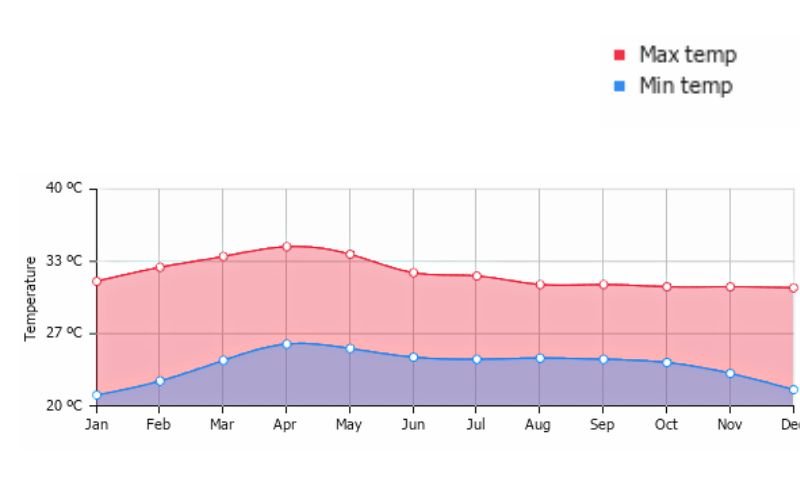
My Tho’s average temperatures
If you prefer dry weather, the months in My Tho with the lowest chance of significant precipitation are February, March, and then January. January is the busiest month for tourism in My Tho, followed by July and May. In My Tho, the spring season, also known as the flower season, lasts from late January to March, making it a pleasant place for tourists to visit. Early summer weather (March to May) is also very pleasant for visitors because it makes the area drier and more convenient for travel.
How to get to and around My Tho
By Plane
There are currently no direct flights to Vinh Long. Tan Son Nhat International Airport and Tra Noc International Airport (Can Tho) are the closest.
By bus
Ho Chi Minh City to My Tho is served by buses and limousine vans. Most include hotel drop-off in My Tho but no pick-up from your Saigon hotel. The trip takes 2 hours and costs between 2.5 and 6 EUR depending on the transfer quality.
By private car
Instead of taking the bus, you can hire a car with a driver who will pick you up from your hotel in Ho Chi Minh City and drive you to My Tho. You can also arrange for a driver to take you to some of the sights along the way.
By Bicycle and motorcycle
While it is possible to rent a motorcycle to explore the Mekong Delta, My Tho, and the beautiful four islets, most visitors prefer to use the free bicycles provided by most resorts and homestays. The roads are bumpy and muddy at times, but the distances are short.
By boat
A boat trip or Mekong River Cruise is one of the best things to do in My Tho, as it is in most Mekong Delta destinations. My Tho is situated on the mighty Mekong River, which has several branches with smaller rivers, which are then linked by various channels. You can travel long distances on the rivers in a motorized boat and see a lot of local river life, such as fishermen and boats carrying massive amounts of fruit. Small traditional sampan boats row you through the palm forests’ smaller side channels.
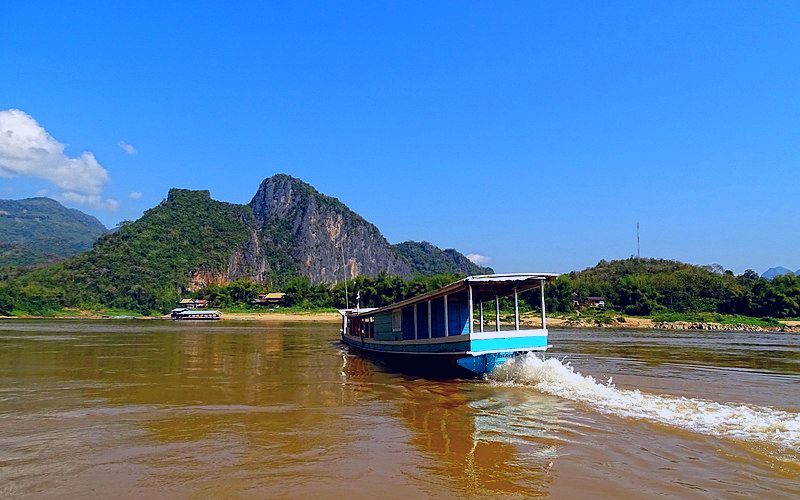
Mekong Cruise
Where to stay in My Tho
Most visitors only stay one night in My Tho, and the city’s lack of good accommodations discourages them from staying longer. The riverbank is within easy walking distance or a short taxi ride from all of My Tho’s accommodations, and every establishment will try to sell you a boat trip.
Here are some popular homestays and hotels:
- Mekong My Tho Hotel
Address: 1A Tet Mau Than Street, Ward 4, My Tho. - The Island Lodge Thoi Son
Address: 390 Ap Thoi Binh, Thoi Son, My Tho - Chuong Duong hotel
Address: 10, Road 30/4, - Happy Farm Tien Giang Homestay
Address: No. 35, Bac Xe Hamlet, Thanh Phu commune, My Tho - Minh Kieu Hotel
Address: No. 2 Thu Khoa Huan, Ward 1, My Tho.
What to See in My Tho
Thoi Son islet (Unicorn islet)
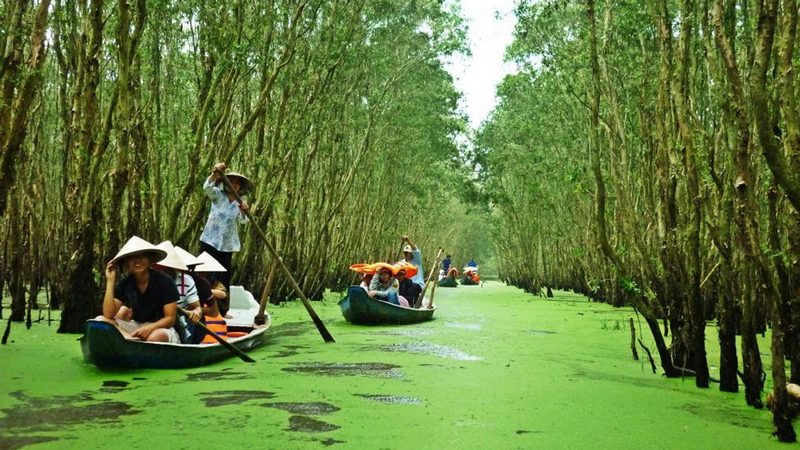
Thoi Son islet
This is the largest of the islands, with a total area of about 660ha and over 1,000 households, including over 6,000 residents, more than 90% of whom are involved in agriculture. Many organized tours departing from Ho Chi Minh City make a stop here for lunch and fruit sampling. Narrow canals allow boats to navigate its interior; gliding along these slender waterways, which are overhung by handsome water-palm fronds that interlock to form a cathedral-like roof, it’s easy to feel like you’re charting new territory. Swooping, electric-blue kingfishers, and sumptuous butterflies add to the romance. Nowadays, tourism is flourishing on the island, so locals can do some tourism service business, such as offering homestays or pubs that serve local foods or selling tropical fruits from the orchards.
Phung islet (Phoenix Islet)
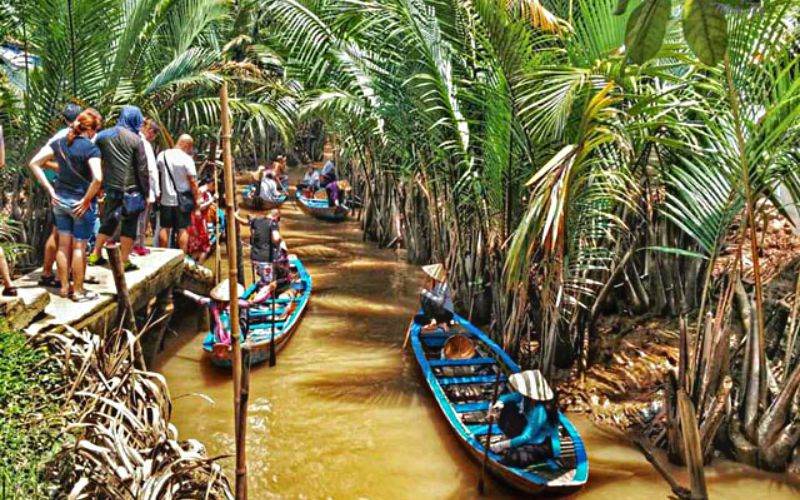
Phung islet
This is famous for being the home of an eccentric religious sect founded three decades ago by the eccentric Coconut Monk, Ong Dao Dua. However, there isn’t much left of his era to see, with only the skeleton of the open-air complex he established remaining. Among the maze of rusted staircases and platforms is the rocket-shaped elevator the monk built to transport him to his private meditation platform. Other features include nine dragon-entwined pillars, which are said to represent the Mekong’s nine tributaries and indicate a Cao Dai influence. The story of the Coconut Monk is told (in Vietnamese) on a magnificent urn that he is said to have made himself from shards of porcelain from France, Japan, and China.
Tan Long Islet (Dragon Islet)
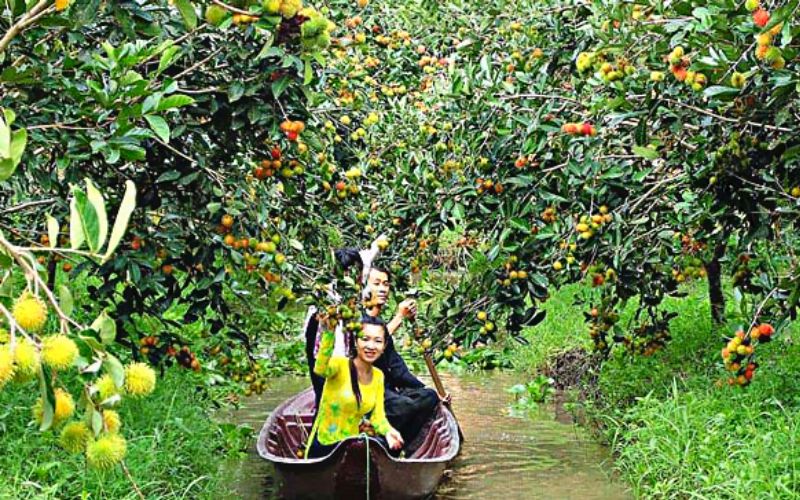
Long islet
Tan Long, the least visited island, has bountiful sapodilla, coconut, and banana plantations, as well as highly regarded longan orchards, beyond its chaotic shoreline of stilt houses and boatyards. Tan Long, like the other islands, is sparsely populated, with small communities of farmers and boat builders.
Con Qui islet (Turtle Islet)
This is the newest of the group, formed by river sediment and stabilized by mangrove planting, and is brimming with longans, dragon fruit, mango, papaya, pineapple, and jackfruit. Just opposite here along the Ben Tre coastline is a small, family-run coconut candy factory where you can watch the coconut being pressed and the extracted juice is mixed with sugar and heated, then dried and cut into bite-size pieces.
Vinh Trang Pagoda
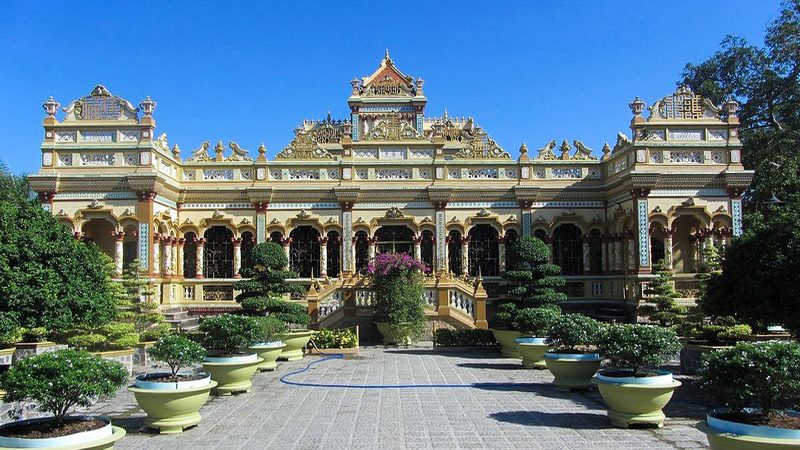
Vinh Trang Pagoda
This pagoda was built in 1849 and is the largest Buddha pagoda in Tien Giang province, as well as the most popular tourist attraction in My Tho. With a total area of 2,000m2, the pagoda’s architecture combines the best of Chinese, Vietnamese, Khmer, and European styles. It has three massive Buddha statues in the yard: the standing Buddha, the Laughing Buddha, and the reclining Buddha. This lovely mixed structure consists of five buildings, two ornamental, and 178 pillars adorned with impressive woodworks and sculptures, such as the set of eighteen Arhant created by a number of artists.
Coconut Candy Traditional Village
With its sweetness of sugar, fragrance, and natural fatty taste of coconut, Vietnamese coconut candy is one of the most popular candies in Vietnam. This is also an excellent souvenir for visitors to Vietnam. According to locals, Vietnam coconut candy first appeared in the 1930s in Mo Cay District, Ben Tre Province, Mekong Delta. It was originally known as Mo Cay candy and was served to guests during the festive seasons or the Tet holiday.
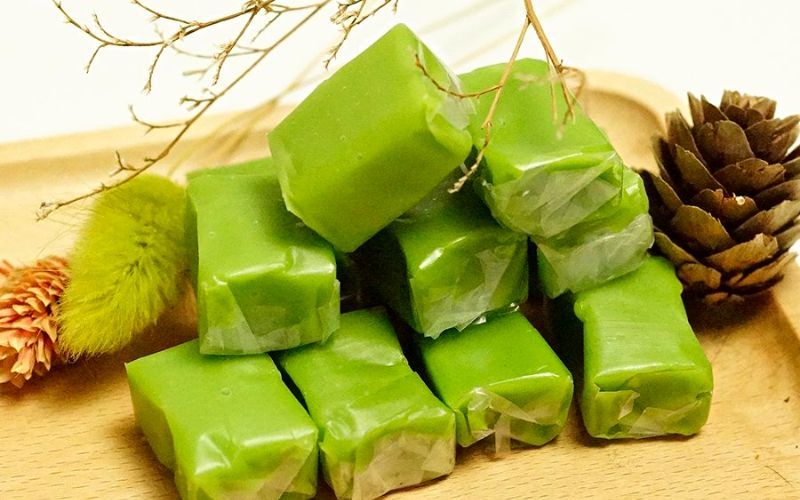
Coconut candy
Since 1970, it has grown in popularity and is now produced on a larger scale. As a result, the specialty has grown in popularity and has become a staple in the gift baskets of visitors to Ben Tre, My Tho Cai Be, and Vinh Long.
Dong Tam Snake Farm
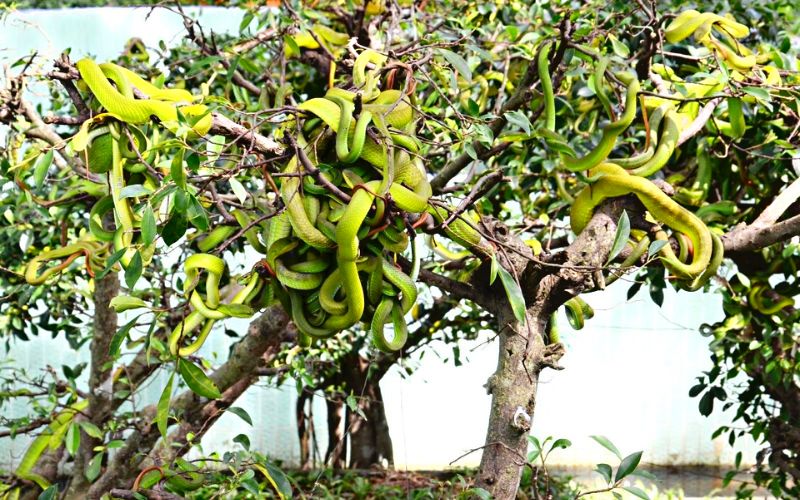
Dong Tam snake farm
Dong Tam snake farm, located 12 kilometers from My Tho city center, is the best place to learn more about snakes. This is regarded as Vietnam’s first snake museum. This farm has a large collection of not only 400 different types of snakes, but also bears, crocodiles, and turtles. Visitors will have the opportunity to learn how snake venom is extracted and used for medicine and other purposes. Additionally, travelers are given information on the farm’s history as well as how to treat snakebites for survival skills.
My Tho Cathedral
My Tho Cathedral is the My Tho family’s third cathedral. With a height of 24 meters, a length of 53 meters, a width of more than 17 meters, the main chamber, and two side rooms, the church is a great Western European-style architectural feat. The dome is adorned with a variety of magnificent designs and motifs, and the basic structure of the building is built in the shape of round pillars to support it. Coming here allows you to take a walk around, get some fresh air, and pray for luck and happiness. You can take some great photos for your travel collection because the cathedral was well designed.
Cai Be Floating Market
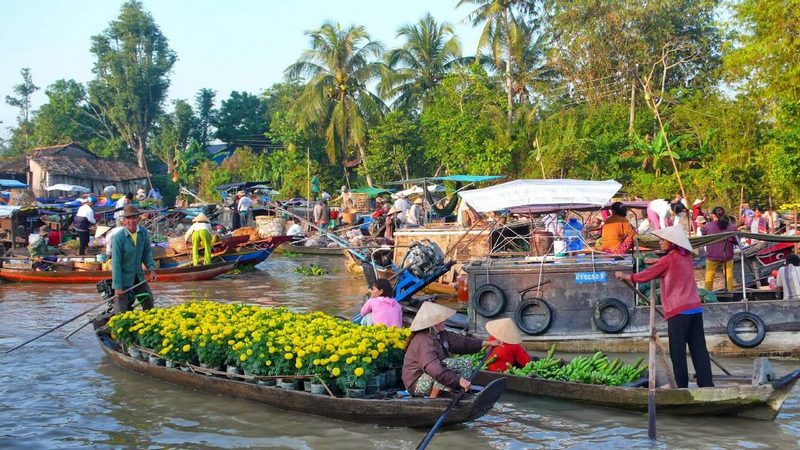
Cai Be Floating Market
This is one of six well-known markets in South Vietnam‘s western region that were established during the Nguyen Dynasty in the nineteenth century. The most well-known tourist attraction in My Tho is the Cai Be Floating Market. The beauty of the Mekong River in our country’s west will take visitors’ breaths away. The Cai Be floating market is technically open all day, but it’s best to go early in the morning.
What to Rat in My Tho
Go Cong tri-spine horseshoe crab
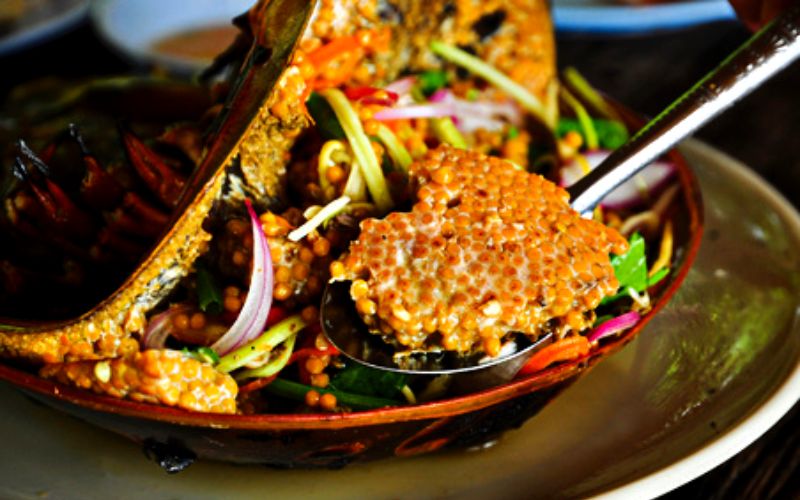
Sam (Horseshoe crab)
This is a tri-spine horseshoe crab from Vietnam that is popular in the Mekong Delta and around Go Cong Beach. The crabs mate from November to March, and the males stick to females, which is why they’re caught during this time of year because it doubles the harvest. Once caught, the crabs are delicately prepared and served as fresh as possible. The meat of these crabs is silky and fibrous, with rich, savory-sweet flavors and a slightly salty aftertaste reminiscent of the ocean and its nutrients.
Grilled Snakehead Fish
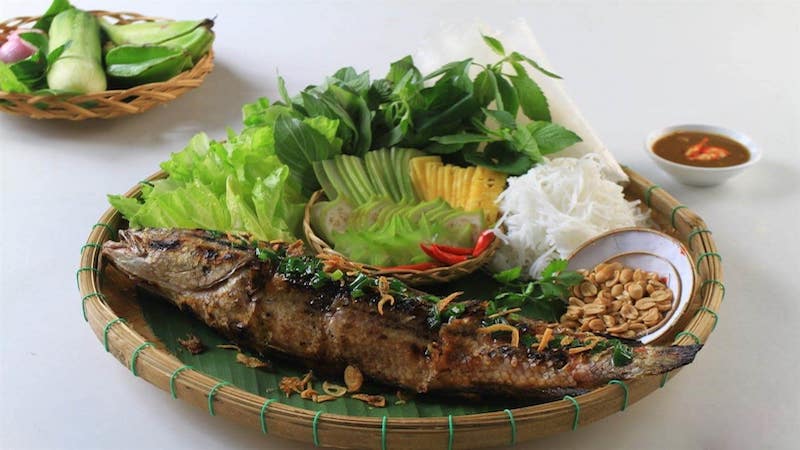
Grilled Snakehead Fish
This is a specialty dish of the South of Vietnam in general, and Tien Giang in particular, with outstanding taste coming from special ingredients and a unique cooking method. To be delicious, the fish must be grilled evenly and served with girdle cakes, fresh vegetables, rice vermicelli, and cucumber. The sauce for this dish is also very simple, consisting of only salt, chili, and pepper, or fish sauce, chopped star fruit, lemon juice, sugar, and chili.
My Tho noodles
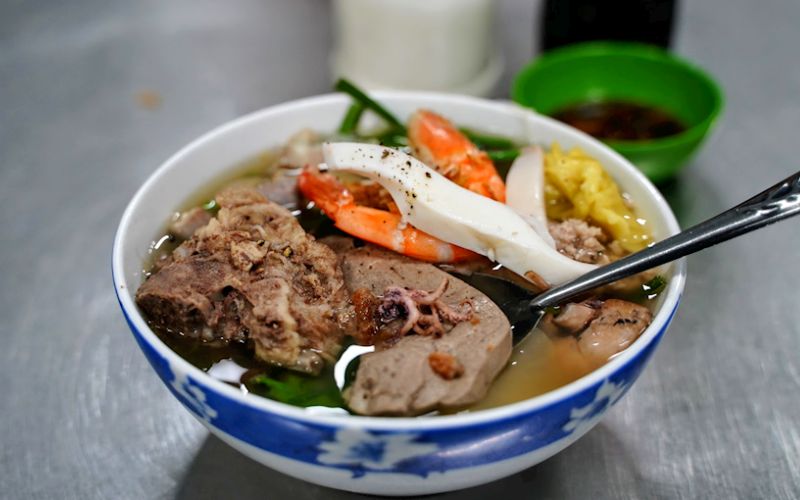
Hu Tieu My Tho
This is a traditional Vietnamese dish from the Mekong Delta’s M Tho. This rice noodle soup was introduced to the region in the 17th century as an ancient Chinese noodle soup, and it has been popular in M Tho since the 1960s. The dish’s components include locally made rice noodles, toppings, and broth. The noodles are made from a local rice variety named Go Cat, which gives the noodles a crunchy and slightly tough consistency. Toppings such as minced garlic, ground pork, quail eggs, shrimp, pork liver, and lime juice are common.
Fruits
The most well-known mango variety from the Mekong Delta is Hoa Loc. When fully ripe, the mangoes are elongated and have bright yellow skin. The yellow flesh has a firm, smooth texture and is low in fiber, while the aroma is fragrant and the flavor is exceptionally sweet.
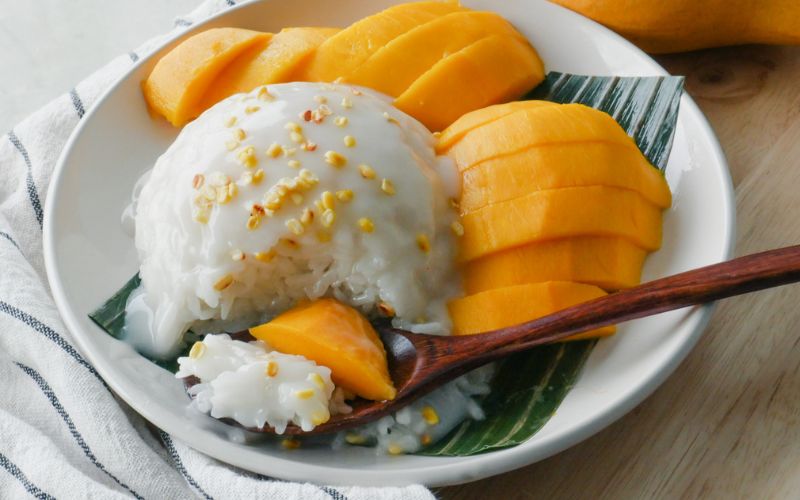
Hoa Loc mango with sticky rice
Furthermore, Vinh Kim is a Vietnamese star apple variety grown in Tien Giang province. The star apples are large, round, aromatic, and refreshingly sweet, with thin skin, thick flesh, and small seeds. From the 10th to the 2nd lunar month, they are in season.
We hope the information in the article will be helpful to you. If you want to have more information and ideas to build an unforgettable itinerary in My Tho, do not hesitate to contact us!
